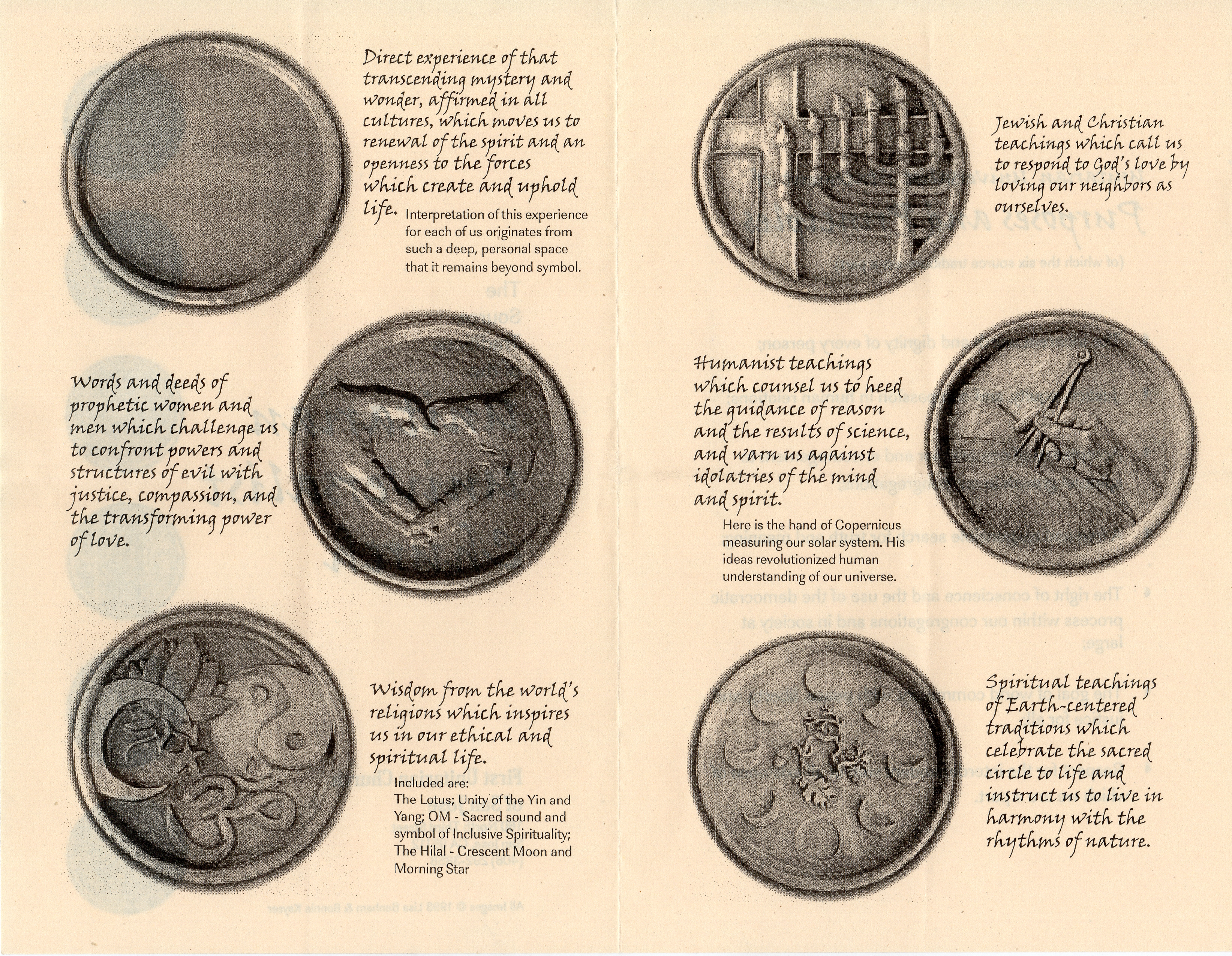
What is on the corner? Itís the whole world!
I mean, itís the Four Corners of the world; otherwise known as the Four Directions. Thereís more than One Direction, you see, or One Corner. The four corners of the world define our world and its cycles. It is a key to everything, in all traditions, ancient and modern.
Our Unitarian Church in San Jose, which itself is a circle with a labyrinth inside it, now has a display of six circular plaques in the front wall of the sanctuary, representing the six sources which Unitarian-Universalists draw from in their quest for truth, love and faith.

The first circle in the upper left corner, that "thing on the corner," is empty, representing the experience of transcendent mystery that encompasses all, and our openness to it. I looked at it, and I remembered that there had been a set of circular plaques posted there years before which represented all the major religions of the world, and Unitarian openness to and interest in them. The first circular plaque on the upper left corner had been the symbol of Christianity, and pictured the Christian cross within the circle. I looked at the new plaque there now, and I thought it looked like the old one with the cross scrubbed out. I thought I could see the cross visible in a whiter color inside the gold-colored empty circle. But I was assured that this was indeed a brand new circular plaque.
I canít deny, however, that I see a faintly-colored cross within that circle. Itís as if someone, or something, knew the ancient metaphysical truth that, in fact, inside every circle, there is indeed a cross. Looking more closely, it looked less like the Christian cross, and looked more like the evenly-spaced cross like the ones made by the Celtics. It wasnít a perfect cross either, but close enough to be significant.
So, the plaque that was intended to be empty, and thus to show our openness to the experience of transcendent wonder, is in fact a circle with a cross inside it. Does this mean that the transcendent is in fact best represented by a cross inside a circle? In many ancient and esoteric traditions, the cross within the circle is a symbol of the universe, because everything in the universe, besides some left-over debris, is in fact a circle (or sphere) with a cross inside it, or is part of such a being. Every star, every sun, every planet and every moon is a sphere that revolves on its axis. The cross of four corners of each world consists first of all of the axis, called the world axis or axial mundi, that runs up and down, or as we say, from north to south. And then secondly, crossing it is the horizon, which is created because the world spins on itself around the axis.
The up and down world axis is something we can notice from our perspective looking at every world from beyond it. The horizon, however, is only noticed by the beings who might be living on those worlds. Other worlds rise and set over this horizon, seen from wherever you may be upon that world. On Planet Earth, these two axes are known as the solar cross, and itís marked out by the monuments and pathways created by ancient peoples around the world. It is the cross between the cycle of the year, and the cycle of the day.
As the Earth makes its yearly cycle around the Sun, the Sun itself seems to move from north to south through the seasons, because the Earthís axis is tilted in relation to the Sun. But the Sun itself crosses that line every day as it moves across the sky, from sunrise to sunset. And the places where the sun rises and sets marks off the horizontal axis of the world. These are the Four Directions, the Four Corners of the World. Sunrise in the East, Sunset in the West, North in the Summer, and South in the Winter. The world axis is also marked off by the two points where the Sun crosses this axis, at Noon and at Midnight.
What strikes me is the difference in perspective between the axis and the horizon. The axis represents what lies beyond, like the universe or the spirit, as it looks down upon the world. And it represents ourselves as we look up toward the divine. It signifies that which is eternal and stable around which our world revolves. It symbolizes the god within ourselves. It connects us with ourselves and the world, and with the higher source that looks down upon us. The horizon, on the other hand, represents us as we look up from the planet, and as we watch the other beings like the Sun, Moon and planets that seem to revolve around us every day from east to west. It represents our connection with other beings. It is our openness to the rapid changes in our lives and our changing interactions with others, just like the speed at which our world turns. The East corner represents the new opportunity to rise to new adventures each morning, and the West is where we let go of the day as the night falls.
Our world and its Four Corners, like the many worlds beyond, connect us with the essence of life, which is an inter-dependent combination between what changes and what stays the same. Within every moment, we experience the eternal, and yet that ongoing eternal moment is constantly changing too. To experience this is the transcendent wonder of life, as indicated by that empty circle in the corner, which has a barely-visible cross that apparently magically created itself inside it. It is the doorway to our lives.